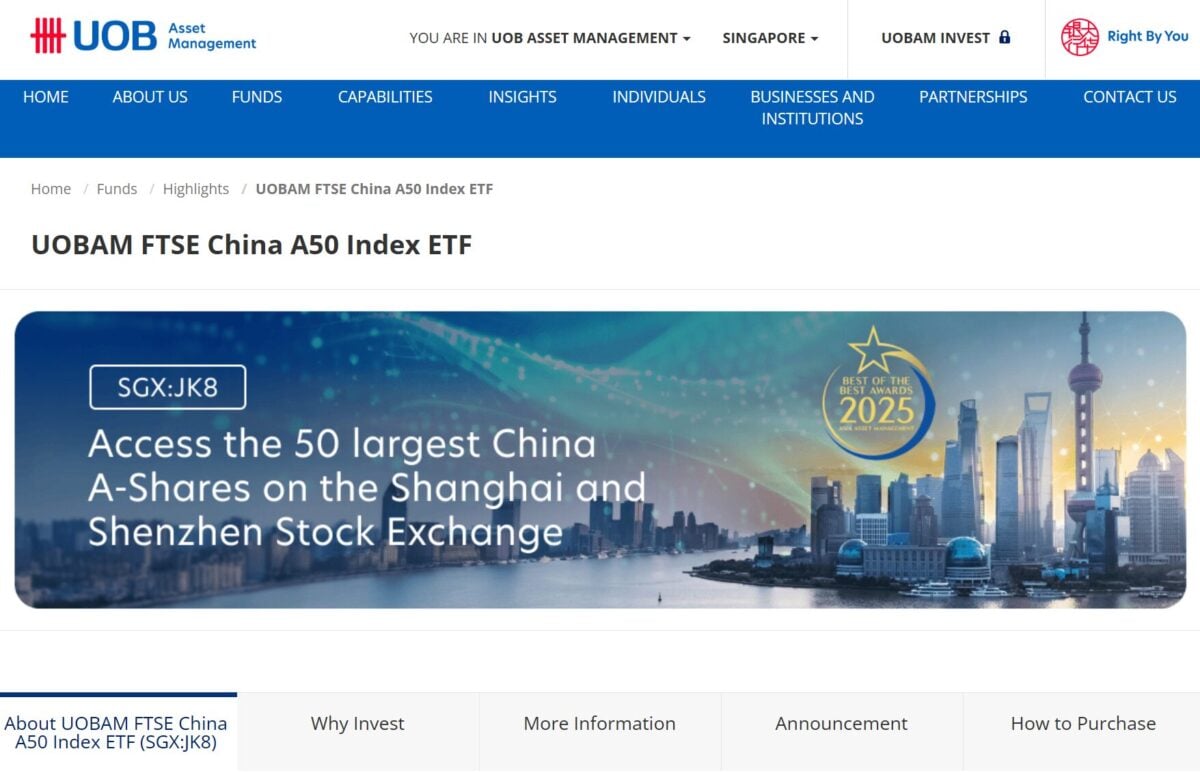ETFs (Exchange-Traded Funds) are very useful investments. ETFs offer instant diversification by holding a basket of securities, and typically have low costs. Trading flexibility is another key advantage, as ETFs can be bought and sold like stocks. ETFs offer access to a wide range of investment options, from broad market indices to specific sectors, commodities, […]
The post Top 8 ETFs to buy for Singapore Investors in 2025 appeared first on Financial Horse.
ETFs (Exchange-Traded Funds) are very useful investments.
ETFs offer instant diversification by holding a basket of securities, and typically have low costs.
Trading flexibility is another key advantage, as ETFs can be bought and sold like stocks.
ETFs offer access to a wide range of investment options, from broad market indices to specific sectors, commodities, or geographic regions.
These are the top 8 ETFs that Singapore investors may wish to consider when building their investment portfolio.

This article was written by a Financial Horse Contributor.
The S&P 500 is a stock market index that tracks the performance of 500 of the largest publicly traded companies in the United States, representing approximately 80% of the total U.S. stock market capitalization.
It serves as a key benchmark for the overall U.S. stock market performance.
It’s basically a no brainer if you want exposure to the US stock market.
The S&p 500 is weighted by market capitalization, giving larger companies more influence, and updated regularly to maintain representation of leading U.S. companies.
For Singapore investors, you can consider the CSPX (London stock exchange listed) for more advantageous tax treatment.
The QQQ (Invesco QQQ Trust) tracks the Nasdaq-100 Index, comprising 100 of the largest non-financial companies. It is heavily weighted toward leading technology companies and innovative sectors.
Top holdings include industry leaders like Apple, NVIDIA, Microsoft, and other tech giants. QQQ is balanced quarterly.
Technology sector commands about 50% of the portfolio. It also provides exposure to key growth areas like artificial intelligence, cloud computing, and digital services, and also has significant holdings in consumer discretionary and healthcare sectors for diversification.
QQQ features a relatively low expense ratio of 0.20% and offers high liquidity as one of the most actively traded ETFs.
While it has higher volatility compared to broader market indices, the QQQ is particularly well-suited for growth-oriented investors seeking exposure to innovative companies and technological advancement.
The iShares Hang Seng TECH ETF (3067) provides access to 30 of the largest Hong Kong-listed technology companies in a single investment.
3067 is focused on high-growth sectors with significant exposure to:
- Technology Services (28.13%)
- Electronic Technology (22.92%)
- Retail Trade (16.74%)
The ETF tracks a relatively new index, which may carry additional risks compared to more established indices.
Concentration in Chinese technology sector means exposure to regulatory and geopolitical risks.
The 3067 ETF is particularly suitable for investors seeking targeted exposure to Chinese technology growth.
We’ve talked about the Nikko AM REIT ETF several times on FH.
The NikkoAM-StraitsTrading Asia ex Japan REIT ETF is basically an ETF of blue chip REITs in Singapore.
It is the largest REIT ETF in Singapore with S$386 million AUM.
The Nikko AM REIT ETF has geographic diversification of 73.5% Singapore REITs, with the remainder in other Asian markets.
There is exposure to multiple real estate sectors:
- Retail (36.9%)
- Industrial (30.1%)
- Office (15.1%)
with competitive expense ratio of 0.55%.
It tracks the FTSE EPRA/NAREIT Asia ex-Japan NET Total Return REIT Index.
Individual REITs capped at 10% to reduce concentration risk.
Obviously as a REIT ETF, performance will be subject to real estate market cycles and interest rate changes. Distributions are also dependent on the underlying REITs performance.
This ETF is particularly suitable for investors seeking broad Asian real estate exposure with regular income potential.
BTW – we share commentary on Singapore Investments every week, so do join our Telegram Channel (or Telegram Group), Facebook and Instagram to stay up to date!
I also share great tips on Twitter.
Don’t forget to sign up for our free weekly newsletter too!
The SPDR Straits Times Index ETF (ES3) tracks the Straits Times Index (STI).
It provides exposure to 30 of the largest and most liquid companies listed on the Singapore Exchange, and represents approximately 70% of the total market capitalization of SGX-listed companies.
There are regular dividend distributions from underlying blue-chip companies
ES3 provides exposure to Singapore’s stable banking, real estate, and telecommunications sectors.
The ES3 ETF is particularly suitable for investors looking to participate in Singapore’s economic growth while receiving regular dividend income.

The iShares MSCI Japan ETF (EWJ) tracks the MSCI Japan Index, providing exposure to 320 Japanese stocks.
The EWJ is of the oldest and largest Japan-focused ETFs with over $16 billion in assets under management.
The Japanese stock market has reached record-breaking highs, surpassing its 1989 peak.
The EWJ’s focus is on large and mid-cap Japanese companies.
It is well-diversified across key sectors including industrials, consumer discretionary, and technology, with regular rebalancing.
There is currency exposure as the fund is not hedged against yen fluctuations.
EWJ is particularly suitable for investors seeking exposure to Japan’s economic growth.
Check out also our review of the Lion-Nomura Japan Active ETF.

The iShares Core MSCI World UCITS ETF (IWDA) tracks the MSCI World Index.
This means it offers broad exposure to large and mid-cap companies across 23 developed countries.
It focuses on large and mid-cap companies in developed markets and includes approximately 1,500 companies across various sectors.
IWDA employs a physical replication method using optimized sampling for efficient tracking.
It is managed by BlackRock and there is regular quarterly rebalancing.
The IWDA is particularly notable for its focus on developed markets only – some other world ETFs that include emerging markets.
The Russell 2000 tracks 2,000 small-cap companies across various sectors in the USA.
It provides exposure to approximately 10% of the total U.S. market capitalization.
There is higher growth potential than large-cap stocks, and more diversified than large-cap indices, reducing dependence on individual companies.
Annual reconstitution maintains true small-cap exposure.
Compared to large-cap indices, there will be higher volatility.
The Russell 2000 is particularly suitable for investors seeking growth potential and broad exposure to the U.S. small-cap market segment.
To recap, these are the top 8 ETFs that Singapore investors can consider when building a strong investment portfolio:
- CSPX – S&P500 (LSE listed)
- QQQ – NASDAQ (Tech)
- 3067 – Hang Seng Tech
- CFA – Nikko AM REIT ETF
- ES3 – STI ETF
- EWJ – iShares Japan ETF
- IWDA – All World
- Russell 2000 – IWM (US small – mid cap)
Any other ETFs that you recommend? Comment below!
ETFs (Exchange-Traded Funds) are very useful investments. ETFs offer instant diversification by holding a basket of securities, and typically have low costs. Trading flexibility is another key advantage, as ETFs can be bought and sold like stocks. ETFs offer access to a wide range of investment options, from broad market indices to specific sectors, commodities,
The post Top 8 ETFs to buy for Singapore Investors in 2025 appeared first on Financial Horse.











